Slow or Fast
- Books Name
- CBSE Class 7 Science Book
- Publication
- Param Publication
- Course
- CBSE Class 7
- Subject
- Science
Slow or fast :
As you know that some vehicles move faster than others. For example : A car moves faster than a cycle. How can one say that an object is moving faster or slower. The distance moved by objects in a given interval of time can help us to decide.
Uniform and Non-uniform motion :
1. Uniform Motion :
A body has a uniform motion if it travels equal distances in equal intervals of time, no matter how small these time intervals may be. For example, a car running at a constant speed of say, 10 m/s, will cover equal distances of 10 metre, in every second, so its motion will be uniform.
Or
If it moves along a straigth line with a constant speed it is said to be in uniform motion.
2. Non-Uniform Motion :
A body has a non-uniform motion if it travels unequal distances in equal intervals of time. For example, if we drop a ball from the roof of a building, we will find that it covers unequal distances in equal intervals of time. It covers :
4.9 metre in the 1st second,
14.7 metre in the 2nd second,
24.5 metre in the 3rd second, and so on.
Or
If the speed of an object is not moving along a straight line keeps changing, its motion is said to be non-uniform.
Uniform and Non-uniform motion can be shown graphically also
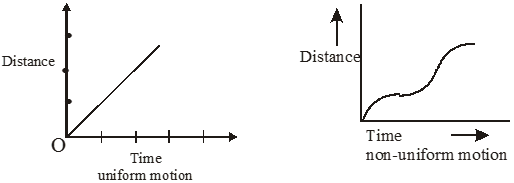
INTRODUCTION :
We observe different types of objects around us. Some of them are at rest for us and some of them are in motion. For instance, tree, houses, etc. are at rest while flying birds, moving cars etc. are in motion.
“Motion is change in position of an object with time.”
As we know that a motion could be along a straight line, circular or periodic.
The branch of physics which deals with the study of the motion of the object is known as Mechanics.It is further divided as.
(i) Statics: Which deals with the study of the objects at rest.
(ii) Kinematics: Which describe motion without going into the cause of motion.
(iii) Dynamics: Which deals with the study of the motion of the objects by taking into the account of the force which cause the motion in the objects.
Rest and motion :
When we look around, we find some objects are in motion whereas, some other objects are at rest. A moving bus, a moving car are in motion. To win a race, the athletes run. They are in motion.The water in a river is in motion. A book lying on the table, a lamp post, a table, a chair, a black board etc., all are at rest.When do we say that an object is in motion? When do we say that it is at rest?
An object in motion is the one that changes its position with respect to its surroundings whereas, an object which is at rest is the one that does not change its position with respect to surroundings.
The rest and motion are relative. An object at rest with respect to one observer may not be at rest with respect to another observer. The same can be said about motion. For a person inside a bus, the fellow passengers are at rest but the same passengers are in motion with respect to a person standing on the ground. If we closely observe the motion of different objects, we find them performing different kinds of motion. A car moving on a straight road, the rotation of blades of a table fan, the motion of a swing which moves to and fro are all different kinds of motion.
Types of Motion :
(i) Random Motion : Motion having no specific path.
Example : Motion of butterfly, Motion of kite.

(ii) Translational Motion : Motion in which all particles of a moving body describes identical trajectory.
Rectilinear Motion
(a) Rectilinear Motion : When a body moves in straight line is known as rectilinear motion. It is also called linear motion.
Examples : The motion of a moving car, a person running, a stone being dropped, motion of a train on a straight track
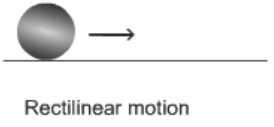
(b) Curvilinear Motion : When a body moves in a curve path, it is known as curvilinear motion.
Examples : Car moving on a curved road.
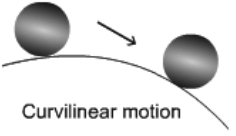
(c) Circular Motion : When a body moves in a circular path, its motion is known as circular motion. In circular motion, the object remains at the same distance from a fixed point.
Examples : Motion of the tip of the clock’s arm, motion of the earth around the sun, motion of blades of fan.

(iii) Rotational Motion : Motion in which a whole body move about an axis is called a rotational motion.
Examples : Motion of top, Rotation of earth
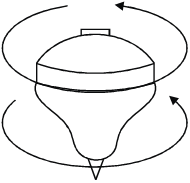
(iv) Periodic Motion : Motion in which an object repeats its motion after a fixed interval of time is called periodic motion.
Examples :
(ii) Motion of a swing.
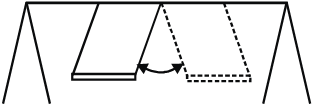
(a) Oscillatory Motion : The to and fro periodic motion of a body around a fix point is called oscillatory motion.
Example : The motion of a simple pendulum, a body suspended from a spring (also called to and fro motion).
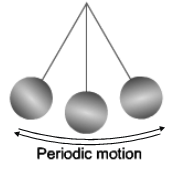
Frame of Reference :
To locate the position of object we need a frame of reference. A convenient way to set up a frame of reference is to choose three mutually perpendicular axes and name them x-y-z axes. The coordinates (x, y, z) of the particle then specify the position of object w.r.t. that frame.
If any one or more coordinates change with time, then we say that the object is moving w.r.t. this frame.
Distance and displacement :
1. Distance :
Distance is the actual path travelled by a body in a given time. Consider a body travelling from A to B along any path between A and B. The actual length of the path that a body travels between A and B is known as the distance. Here if the body goes from A to B via C, the distance travel will be ACB.
The distance travelled will be different for different paths between A and B. It is a scalar quantity.

2. Displacement :
The distance travelled in a given direction is the displacement. Thus displacement is the shortest distance between the given points. It is a vector quantity. S.I. unit of distance and displacement is metre.
e.g. : A body starts from A and moves according to given figure.

The distance and displaemcent are as follows for different path.
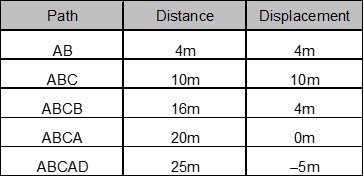
Note :
(i) : If a body travels in such a way that it comes back to its starting position, then the displacement is zero. However, distance travelled is never zero.
![]()
Ex.1 A train starts from station A and moves towards station B along a straight path which is 100 km from A. Reaching B it turns back and stops midway between A and B. Find the distance and displacement of train. Neglect length of train.
Sol. Say the midpoint as C.

∴ Distance = AB + BC = 100 + 50 = 150 km
and Displacement = AC = 50 km or 50 km along east.
Difference between distance and displacement :
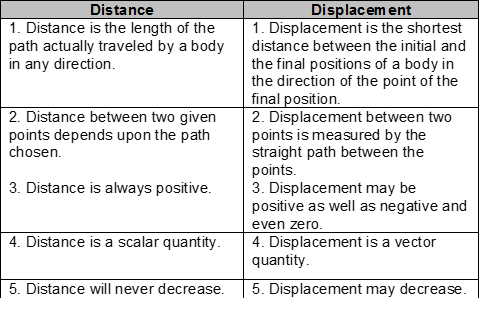
Speed
- Books Name
- CBSE Class 7 Science Book
- Publication
- Param Publication
- Course
- CBSE Class 7
- Subject
- Science
Speed :
It is the characterstic of an object which decide the motion of an object. Distance covered in a unit time is called speed.
![]()
It is measured in m/sec.
Unit of speed
The basic units of speed is meter/second, which can also be expressed in m/min, km/h etc.
Kind of speed:
(i) Uniform speed : Consider a car moving on a road such that it covers, say 10 m in one second. If it covers 10 m in every subsequent second, then its speed is said to be uniform. Thus, when a body covers equal distances in equal intervals of time, however small the time interval may be, then the speed of the body is said to be uniform.
(ii) Non-uniform speed : When a body covers unequal distances in equal intervals of time or when it covers equal distances in unequal intervals of time, then the speed of the body is said to be non-uniform. Motion of a bus after application of brakes is an example of non-uniform speed.
(iii) Instantaneous Speed : The speed of an object at any particular instant of time or at a particular point of its path is called the instantaneous speed of the object. It is measured by speedometer in an automobile.
(iv) Average Speed : For an object moving with variable speed, it is the total distance travelled by an object divided by the total time taken to cover that distance.
![]()
Ex.2 A bus leaves Delhi 7 PM and reaches Mumbai at 9 PM. The speed of the bus is 20 km/h. What is the distance between Mumbai and Delhi ?
Sol. Distance = Speed × Time = 20 × 2 = 40 km (Time = 9 – 7 = 2 hour)
Ex.3 A car travels at 10 m/s. Express the same speed in km/h.
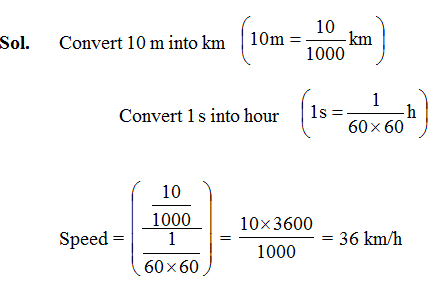
Ex.4 A car covers 1000 m in 10 sec and a cycle cover 50 m in 10 sec. Which one is faster ?
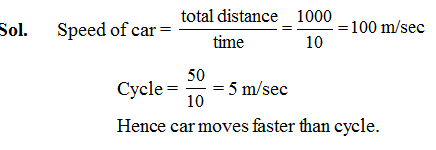
Ex.5 A car travels 30 km at a uniform speed of 40 km/h and the next 30 km at a uniform speed of 20 km/h. Find its average speed.
Sol. Given,
Total distance, d = (30 + 30) = 60 km
Speed for the first 30 km (u1) = 40 km/h
Speed for the next 30 km (u2) = 20 km/h
To calculate :
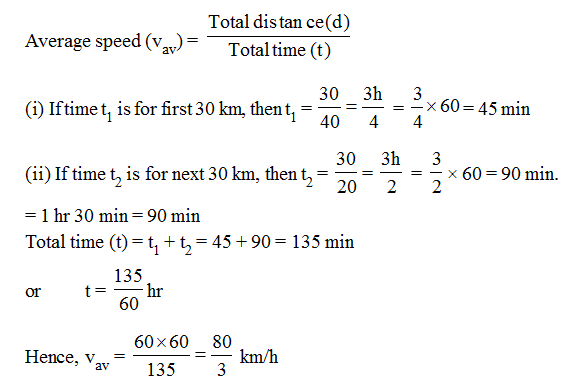
Velocity :
When an object moves with certain speed, it is not clear in which direction it is moving. To overcome the shortcoming, another term, velocity is used. In a way, velocity is speed in a specified direction. Thus, velocity consists of two parts out of which one part is direction. For example, a car moving with 10 ms–1 in east direction has the magnitude of velocity as 10 m s–1 and the direction is east.
It is the rate of change of displacement.

1. Uniform Velocity: When a body moves with uniform speed in a specified direction, it is said to be moving with uniform velocity.
Thus, a body moves with uniform velocity when its magnitude as well as its direction remains the same.
Example: Aeroplane moving with 500 km/hr towards east.
2. Variable velocity: When a body moves such that either its magnitude or direction or both change, then it is said to be moving with variable velocity.
Example: A car moving on a straight road such that its speed changes from time to time has variable velocity. A car taking a turn has variable velocity as its direction changes.
3. Instantaneous Velocity :
The velocity of an object at any given instant of time at particular point of its path is called its instantaneous velocity.
4. Average velocity: When a body moves with variable velocity, the average velocity of the body is equal to the ratio of total displacement of the body to the total time taken.
Average velocity = Total displacement / Total time taken
Difference between Speed and velocity :

Ex.6 An object travels with a velocity of 1.5 m/s eastwards for 2s and then with a velocity of 4 m/s northwards for 1s. What is its final displacement at the end of 3 s ? (Use property of right angles)
Sol. Displacement along OA = Velocity × Time = 1.5 × 2 = 3 m
Displacement along AB = Velocity × Time = 4 × 1 = 4 m
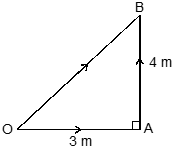

Ex.7 A car is moving along x-axis. As shown in figure it moves from O to P in 18 s and returns from P to Q in 6 sec. What is the average velocity and average speed of the car in going from (i) O to P and (ii) from O to P and back to Q.
![]()
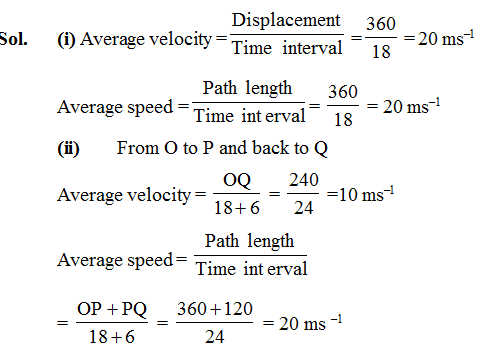

Acceleration :
Mostly the velocity of a moving object changes either in magnitude or in direction or in both when the object moves. Then the body is said to have acceleration.
The change in velocity of a body per unit time is called the acceleration or the rate of change of velocity is called the acceleration.
The SI unit of acceleration is ms–2. The other units of acceleration are cm s–2 and km h–2.
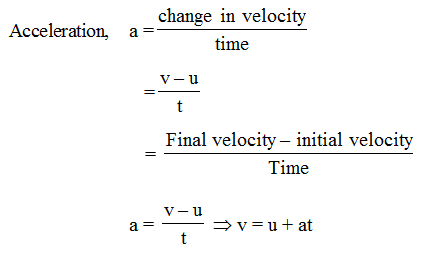
• Types of Acceleration :
(i) Positive acceleration: If the velocity of an object increases in the same direction, the object has a positive acceleration.
Eg. : A freely falling body.
(ii) Negative acceleration (retardation): If the velocity of a body decreases in the same direction, the body has a negative acceleration or it is said to be retardation.
Eg: A train slows down.
Ex.9 The velocity of a car at 10 : 50 am is 60 km/h and at 10: 52 am it is 80 km/h. Assuming constant acceleration in the given period, find its value.

Ex.10 An object is sliding down an inclined plane. The velocity changes at a constant rate from 10 cm/s to 15 cm/s in two seconds. What is its acceleration ?

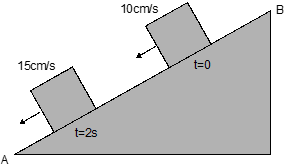
Measurement of Time
- Books Name
- CBSE Class 7 Science Book
- Publication
- Param Publication
- Course
- CBSE Class 7
- Subject
- Science
Measurement of Time :
Time plays an important role in our life. Any change, or movement which takes place, is understood in terms of a physical dimension called ‘time’.
There are many phenomenon by which we can understand time.
(i) The time between one sunrise and the next is called a solar day.
(ii) A month is measured from one new moon to the next.
(iii) The time taken by the earth to complete one revolution around the sun is called year.
The early scientist developed many devices to measures time intervals. All of them make use of some periodic motion.
Sundial :
People in older times measured intervals of time shorter than a day with a device called sundial The device worked on the principle that as the position of the sun in the sky changed, so did the position and length of the shadow cast by an object. The decrease and then increase in the length of the shadow during day time was used to measure time in sundials. The sundial has a triangular metallic plate called gnomon fixed vertically at the centre of a circular plate. The device is placed in the open in such a way that gnomon points in the north south direction. The shadow of gnomon on the circular scale shows the time at that particular moment. Sundials indicate time quite accurately but the problem with them is that they cannot be used after sunset or on a cloudy day they can also not be carried along to different places. One sundial can be seen at Jantar Mantar in New Delhi.
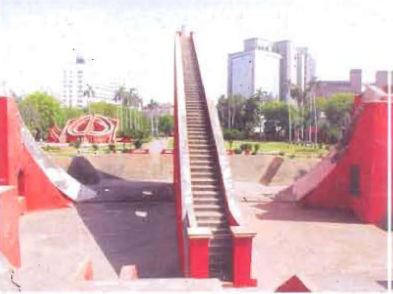
Candle Clocks and Sand Clocks :
Romans actually used sand clocks which worked on the principle that a definite amount of sand takes constant time to fall from the upper chamber to the lower chamber. That constant time was the unit of measurement of time commonly called an hour. The sand clock is also called an hourglass. Once the upper chamber is emptied completely, the hourglass is turned upside down to record the time again.
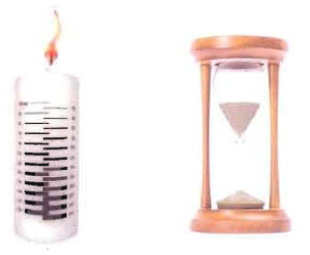
Simple Pendulum :
Any event or motion which repeats itself after a constant time is called periodic motion.One of the most common periodic motion is that of a simple pendulum.
A simple pendulum consists of a small metallic ball or a piece of stone suspended from a rigid stand by a thread. The metallic ball is called the bob of the pendulum.
Figure (a) shows the pendulum at rest in its mean position. When the bob of the pendulum is released after taking it slightly to one side, it begins to move to and fro, in figure (b). The to and fro motion of a simple pendulum is an example of a periodic or an oscillatory motion.
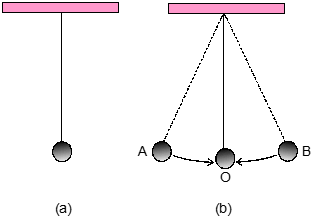
The pendulum is said to have completed one oscillation when its bob, starting from its mean position O, moves from A to B and back to O. The pendulum also completes one oscillation when its bob moves from one extreme position A to the other extreme position B and comes back to A. The time taken by the pendulum to complete one oscillation is called its time period.
Units of Time :
The basic unit of time is second. Its symbol is s or sec. Other units are minutes (1 hour = 60 min),
(1 min = 60 sec), hour day (1 solar day = 24 hours), 1 year (365 days).
1 solar day = 24 × 60 × 60 = 86400 s
1 second = 1/86400th of a solar day
Note :
(i) The symbols of all units are written in singular.
(ii) Other smallest units of time 1 second = 106 microsecond; 1 sewcond = 109 nanosecond.
Measuring Speed
- Books Name
- CBSE Class 7 Science Book
- Publication
- Param Publication
- Course
- CBSE Class 7
- Subject
- Science
Measuring Speed :
After knowing the measurement of time and distance we can measure speed of a given object.
If we roll a ball on the ground and note the distance covered in given time we can easily measure the speed of the object.
For example, let a ball covers 10 meter in 5 sec. than the speed will be
![]()
There are many devices by which speed can be measured directly one of them is speedometer, which is fitted on the top of a scooter, or a motor cycle, car etc.
There is another device, which measures the distance moved by the vehicle called an odometer.
LET US RECAPITULATE
1. Measurement of time:
(i) For measuring the time, our ancestors used sundials, water clocks and sand clocks.
(ii) The watches (or clocks) used today make use of some periodic motion. One of the most well-known periodic motions is that of a simple pendulum, e.g., Wall clock, table clock, Digital clock etc.
2. Simple Pendulum:
(i) A simple pendulum consists of a small metallic ball called bob, suspended from a rigid stand by a thread.
(ii) When the bob of the pendulum is released after taking it slightly to one side, it begins to move to and fro. The to and fro motion of a simple pendulum is an example of an oscillatory or a periodic motion.
(iii) One oscillation: The pendulum has said to have completed one oscillation when its bob moves from one extreme position to the another extreme position and comes back to first extreme position.
(iv) Time period: Time taken by the pendulum to complete one oscillation is called its time period.
3. Units of time and speed :
(i) The basic unit of time is second. Its symbol is's'.
(ii) The basic unit of speed is m/s.
However, it could be expressed in other units also such as m/min or km/h.
4. Speedometer: It is a device to record the speed (of vehicle). It records the speed directly in km/h.
5. Odometer: It is a device to measure the distance moved by the vehicle.
6. Graphical representation of data: We can represent the data in pictorial form by three ways:
(i) Bar graph (ii) Pie chart (iii) Line graph
7. Motion of an object can be presented in pictorial form by their distance-time graph. The distance-time graph for the motion of an object moving with a constant speed is a straight line.
8. Speed of objects help us to decide which one is moving faster than the other.
9. A pendulum of about 25 cm length takes exactly one second to complete one oscillation.
10. The average speed of a Fox - 42 mph, Lion - 50 mph, Horse - 55 mph, Cheetah - 70-80 mph
(mph- miles per hour)
KEY WORDS
1. Bar graph: A graph in which quantities are represented in form of bars of different heights.
2. Graphs: It is mathematical pictorial representation of the relation between two inter-dependent physical quantities.
3. Non-uniform motion: If a body covers unequal distances in equal intervals of time or equal distances in unequal intervals of time, then it is said to be in a non-uniform motion.
4. Oscillatory motion: The to and fro motion of a simple pendulum about its mean position is called oscillatory motion.
5. Speed: It is defined as the distance travelled per unit time. Thus
![]()
6. Time period: Time taken by the pendulum for one oscillation is called time period.
7. Uniform motion: It can be defined as the motion in which a body travels equal distances in equal intervals of time.
8. Unit of time: The S.I. unit of time is second.
Distance-Time Graph.
- Books Name
- CBSE Class 7 Science Book
- Publication
- Param Publication
- Course
- CBSE Class 7
- Subject
- Science
Distance - Time Graph :
Let us try to understand the nature of motion of an object.
Time Odometer reading Distance from the strating points
8.00 am 1000 km 0 km
8.30 am 1100 km 100 km
9.00 am 1200 km 200 km
9.30 am 1300 km 300 km
10.00 am 1400 km 400 km
If we plot the graph between distance and time.
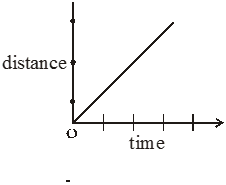
A straight line is obtained. Which mean that its a uniform motion and the speed of the object is constant.
While ploting a graph, one must keep in mind.
(a) The difference between the highest and the lowest values of each quantity.
(b) The intermediate values of each quantity, so that with the scale chosen, it is convenient to mark the values on the graph.
(c) To utilise the maximum part of the paper on which the graph is to be drawn.
Ex.11 The figure given below shows the graphical representation of the movement of a body. Find its speed after three seconds. What information do you get from the graph?
Sol. Draw a perpendicular on the X-axis from point A (i.e., three seconds on time scale) which intersects the graph at point T. Now draw a line from T, parallel to X-axis which intersects the Y-axis at point B. You can now calculate the speed ofthe moving body after three seconds.
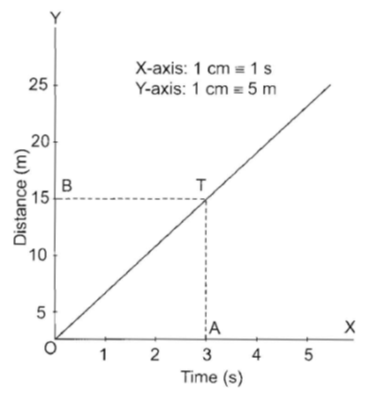

The information provided by a distance-time graph is as follows:
• The distance travelled by the body at a particular point of time
• The speed of the moving body
• The speed of the moving body is uniform
Extended Learning – Activities and Projects
1. To observe the length of shadows during day time :
• Take a stick for this purpose and fix it in the open ground away from trees and buildings as shown in figure.
• Now observe the length of the shadow of the stick at different times of the day.
• Use a measuring tape to measure the length of the shadow. You will observe that the length of the shadow of the stick is smallest at noon when the sun is just above it. It is longest in the morning and evening when the sun is low in the sky. The shadow of the stick falls in a direction opposite to that of the source of light, i.e., the sun. So, the shadow moves according to the change in the position of the sun relative to the stick.
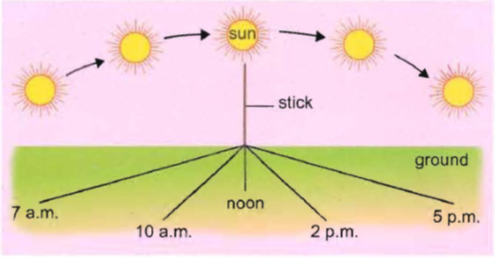
2. Collect information about time-measuring devices that were used in the ancient times in different parts of the world. Prepare a brief write up on each one of them. The write up may include the name of the device, the place of its origin, the period when it was used, the unit in which the time was measured by it and a drawing or a photograph of the device, if available.
(i) Rolling Ball clock. invented in 17th century by French engineer Nicolas Grollier. unit of time-15 seconds-1 min.
(ii) Candle clock.
used as early as A.D. 520 in China
unit of time-30 min to hrs.
(iii) Water clock
used in 16th century B.C. in Babylon
Uses steady flow of water to keep track of time.
3. You can perform an interesting activity when you visit a park to ride a swing. You will require a watch. Make the swing oscillate without anyone sitting on it. Find its time period in the same way as you did for the pendulum. Make sure that there are no jerks in the motion of the swing. Ask one of your friends to sit on the swing. Push it once and let it swing naturally. Again measure its time period. Repeat the activity with different persons sitting on the swing.
(i) Compare the time period of the swing measured in different cases.
(ii) What conclusions do you draw from this activity?
(i) Time is same in every case.
(ii) Time period does not depend upon mass.
4. To make an hourglass or sand clock :
• Take two transparent plastic bottles of equal size.
• Cut a cardboard disc large enough to cover the mouths of the bottles and make a small hole in the centre of the cardboard.
• Put some sand in one bottle and place the cardboard disc on its mouth.
• Now invert the other bottle over the disc and with the help of a tape, seal the mouth of the two bottles as shown in figure. You r sand clock is ready. Invert the sand clock and watch the flow of sand. Note the time taken by the sand to flow from the bottle on top to the bottle at the bottom. Repeat the procedure. Note the time taken in each case.There is no difference in the time taken for the bottle to empty in both cases. You can measure a particular span of time with this sand clock.

5. To observe slow and fast motion and calculate the average speed :
• For this activity, you can use the football field or even the playground.
• With the help of a measuring tape, measure and mark a distance of 200 metres.
• Now ask your friends/classmates to travel this distance:
(a) walking slowly
(b) walking briskly
(c) running
(d) on a bicycle
• Measure the time taken by each one to travel this distance with the help of a stopwatch and note your observations as shown in the example in Table.
Time taken to cover a distance of 200 metres

You will observe that :
• Minimum time is taken to travel the distance on a bicycle, thus it has the maximum speed.
• Maximum time is taken to travel the distance while walking slowly, so the speed is minimum here.
• The order of time taken is: slow walk> brisk walk> ru nning> cycling.
• The order of speed is: slow walk < brisk walk < running < cycling ,
Motion is dependent on the speed of the body. Higher the speed, faster is the motion and vice versa.
6. To find the speed of a moving ball :
• Take a ball, a measuring tape, a stopwatch and three of your friends to a playground.
• Put a mark or line on the ground and ask your friends to gently slide or throw the ball in one direction from this mark.
• When the ball comes to rest, mark this position also.
• Now measure the distance between the two markings which gives the distance travelled by the ball.
• Also measure the time taken by the ball to reach the state of rest with the help of the stopwatch.
• Put the values of distance and time taken in Table against the name of the boy/girl and also calculate the speed as shown in the given example.
Table : Distance travelled and time taken by a moving ball

Slow or Fast
Chapter 13: Motion and Time
One of the most well-known periodic motions is that of a simple pendulum. In everyday life we seldom find objects moving with a constant speed over long distances or for long durations of time. If the speed of an object moving along a straight line keeps changing, its motion is said to be non-uniform.
Slow and fast moving objects
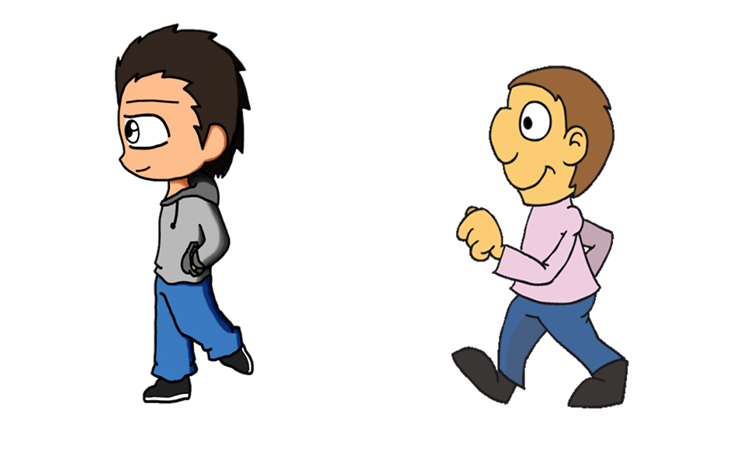
We already know that a moving object shows three kinds of motion, the rectilinear motion, the circular motion and the periodic motion. But how do we know whether the motion is slow or fast? This we decide by seeing the speed with which an object moves. Now, what is speed? A very common word for movement, speed designates the rate of change in position. Before discussing speed lets discuss the varying levels of motion. You might have seen bullock carts, cars, scooters, and bicycles moving. How do you tell which one shows slow motion and which one shows fast motion? The answer here is simple, you compare them and their change in positions with regard to time. When all of these vehicles move in the same direction, we accurately know which one is moving faster.
Speed
Speed
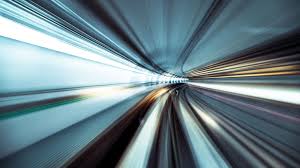
Speed is the distance traveled per unit of time. It is how fast an object is moving. Speed is the scalar quantity that is the magnitude of the velocity vector. It doesn’t have a direction
Measurement of Time
Measurement of time
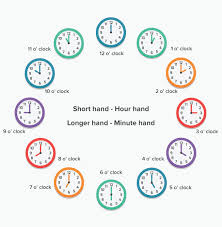
To measure time is to measure the length of time. We know the following units of measuring time: second, minute, hour, day, week, fortnight, month, year, century. There are various methods of measuring time in different parts of the world. Of these, the Common or Christian Era is most widely used.
Measuring Speed
Measuring speed
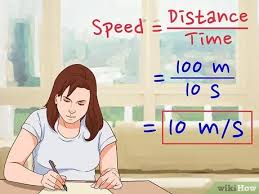
The formula for speed is speed = distance ÷ time. To work out what the units are for speed, you need to know the units for distance and time.
In this example, distance is in metres (m) and time is in seconds (s), so the units will be in metres per second (m/s).
Distance Time Graph
Distance time graph
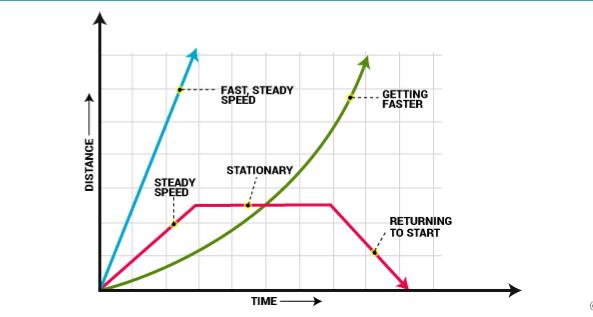
If an object moves along a straight line, the distance travelled can be represented by a distance-time graph. In a distance-time graph, the gradient of the line is equal to the speed of the object. The greater the gradient (and the steeper the line) the faster the object is moving

 Param Publication
Param Publication
 Grow Career Publication
Grow Career Publication
